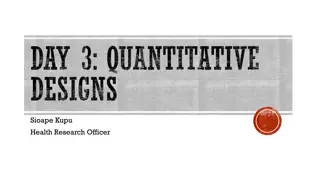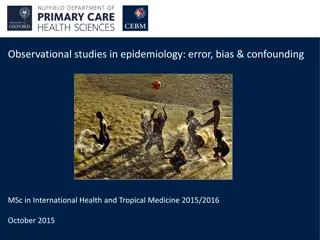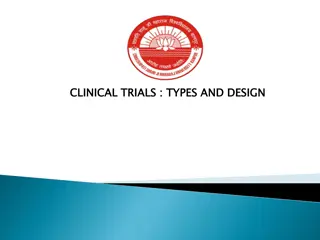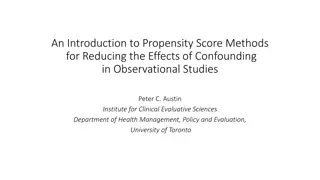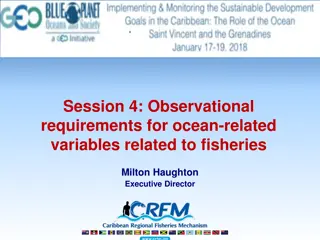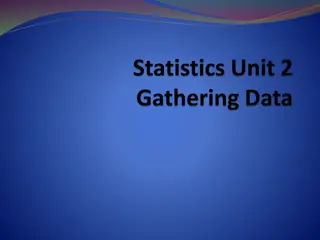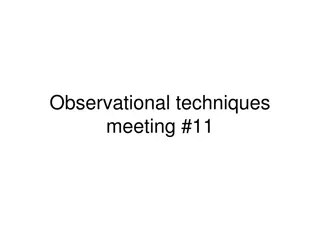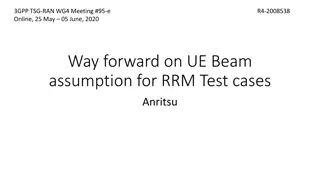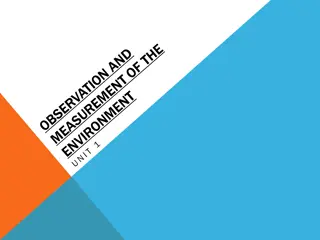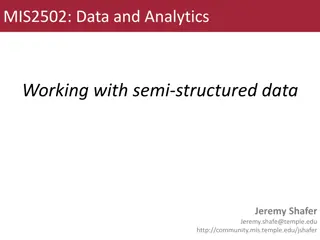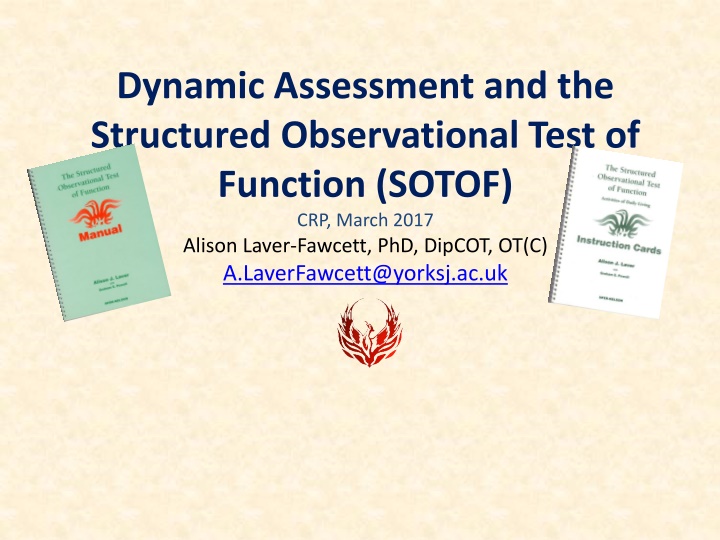
SOTOF: A Dynamic Assessment Tool for Occupational Therapists
Explore the Structured Observational Test of Function (SOTOF), an assessment tool used in Occupational Therapy practice to evaluate ADL skills, neurological function, and more in older adults with possible neurological disturbances. Developed by Alison Laver-Fawcett, this tool provides detailed insights into functional status and neuropsychological deficits, offering a valuable resource for occupational therapists specializing in neurology and geriatrics.
Download Presentation

Please find below an Image/Link to download the presentation.
The content on the website is provided AS IS for your information and personal use only. It may not be sold, licensed, or shared on other websites without obtaining consent from the author. If you encounter any issues during the download, it is possible that the publisher has removed the file from their server.
You are allowed to download the files provided on this website for personal or commercial use, subject to the condition that they are used lawfully. All files are the property of their respective owners.
The content on the website is provided AS IS for your information and personal use only. It may not be sold, licensed, or shared on other websites without obtaining consent from the author.
E N D
Presentation Transcript
Dynamic Assessment and the Structured Observational Test of Function (SOTOF) CRP, March 2017 Alison Laver-Fawcett, PhD, DipCOT, OT(C) A.LaverFawcett@yorksj.ac.uk
SOTOF references Original reference Laver AJ, Powell GE (1995) The Structured Observational test of Function (SOTOF). Windsor: NFER-Nelson 2ndedition Laver-Fawcett AJ, Marrison, E (2016) Structured Observational test of Function (SOTOF). 2ndedition. York: York St John University How to get a copy: Please contact Alison at: a.laverfawcett@yorksj.ac.uk
Structured Observational test of Function (SOTOF) A structured assessment tool used in OT practice that uses elements of a dynamic ( interactive ) approach to assess ADL skills Developed to provide a detailed description of functional status and associated neuropsychological deficits within a structured evaluation of ADL Aims to evaluate performance of activities of daily living and provides detailed information on neurological function.
SOTOF Recognised as a useful assessment of body function and structure for occupational therapists specifically within neurology and for older people (College of Occupational Therapists, 2003; 2004; Clarke et al., 2001).
SOTOF - introduction Developed for use with older adults (age 60 years and above) with possible neurological disturbance. This includes people with stroke, head injury, Parkinson s disease and / or dementia It is a descriptive assessment, but can be used to evaluate changes in function over time. The 2ndedition enhances the dynamic assessment element of SOTOF which may be useful for predictive assessment a predictive validity study is required to test this.
Background to the development of SOTOF I started developing the SOTOF in 1989 as I was frustrated by the limitations in both informal assessment and standardised tests available at that time initial ideas emerged during a 1 week residential course on Standardised assessment. It became the focus of my MPhil PhD studies It took 5 years of research to do this initial development work 1990 1995 SOTOF was published in 1995
What is Dynamic Assessment? Dynamic assessment is a non traditional approach to evaluation that uses cues, mediation, feedback, or alterations of activity demands during assessment to examine changes in performance. Unlike standardised assessments the focus is not on the outcome of performance but on the process of learning and change Toglia, Golisz & Goverover, 2009
What is Dynamic Assessment? Dynamic assessment is an interactive procedure that systematically and objectively measures the degree of change that occurs in response to cues, strategies, feedback, or task conditions that are introduced during testing Toglia, 2009
Intervention techniques are embedded within assessment procedures in a deliberate effort to produce changes in performance that are systematically observed and measured . Toglia, 2009
In contrast to static assessment, dynamic assessment focuses on individual variations and changes rather than on comparison to normative or typical performance. The goal is to measure how and to what extent performance can improve with guidance . Toglia, 2009
Missiuna (1987) Contrasts dynamic assessment with traditional assessment models: i.e. standardised and informal. Primary distinction lies in the purpose of the assessment dynamic assessment is a model of clinical assessment which emphasises how and why an individual learns a task or skill rather than the more traditional assessment of what he has already learned (p18).
Dynamic Assessment differs from informal assessment in that a systematic process is utilised to determine an individuals characteristic process and behavioural functioning . Role of therapist also differs instead of adopting a neutral role the assessor becomes an active mediator aiming to provide the best conditions for task success . Missiuna (1987)
Assessment paradigms Positivist Non individualised Static function Quantitative Measurement normative/criteria Humanistic Individualised Flexible Subjective Qualitative Standardised assessment Informal assessment Based on Activity theory (Vygotsky) Process oriented Transactional Flexible/individualised Measures change/response Quantitative and qualitative Dynamic assessment While each assessment model has some attributes in common they are based on different philosophies and scientific paradigms
Zone of Proximal development - Mark Just right challenge Facilitatory / scaffolding Compensatory Maintenance ZPD Dynamic assessment Could do with mediation e.g. short feeding motor sequence, Attention to task, perceive plate Current level of independent functioning e.g. hold spoon, recognise food What Mark cannot do even with help e.g. use knife, collect food, manage risks
Key points - Dynamic assessment is: An interactive, collaborative and transactional process Structured and systematic Includes intervention and facilitation You can use cues and prompts or other mediational techniques You can enable interactive problem solving through feedback and facilitated strategy use You can adapt demands within the task environment You can use motivational techniques Potential focussed plasticity Good fit with occupational therapy and person centred approaches Core skills - activity analysis and therapeutic use of self central Grounded in modern theories of cognition and skill development
SOTOF (2nd edition) Graduated mediation protocol As adapted from EFPT (Baum and Wolf, 2013) and DLOCTA-G (Katz et al., 2011) 0 Independent The person is independent completing the task. No prompting or assistance is required from the clinician. 1 General prompt This could be a statement (Katz et al., 2011) e.g. take your time or could be a general question e.g. what do you think is the next step? or what else might you need to complete this task? (Baum and Wolf, 2013 p.3). This is not an action or telling the person what to do. 2 Gestural Cue This could be miming the action that is required to complete the particular task or a movement that may guide the participant. This may include pointing to where they might find an item or pointing to equipment they may need to complete the task (Baum and Wolf, 2013). 3 Specific feedback/cue This is a verbal cue. It may be feedback (Katz et al., 2011) such as there is a mistake, can you try and correct it or a command such as pick up the cup (Baum and Wolf, 2013 p.3). This clinician physically supports the person to complete an action, e.g. hold the shirt whilst the person puts his / her first arm in the sleeve (Baum and Wolf, 2013). The clinician reduces the amount of stimuli or modifies the environment to reduce the task demand (e.g. changing the physical environment; Katz et al., 2011). The clinician may also do the action in order for the person to copy (Katz et al., 2011). The person should still be attending to the task (Baum and Wolf, 2013). The clinician physically guides the movement but allowing the person to lead and withdraws the physical assistance if the person takes over the movement (Sanderson and Gitsham, 1991). 4 Physical assistance / Co-active assistance/ modifications 5 Do for the person The person is unable to complete the task so the clinician completes the task, or the part of the task, for the person.
SOTOF Addresses 4 assessment questions: How does the person perform ADL tasks independently or with intervention? (if so what?) What skill components does the person have that are intact and which areas have been affected by neurological impairment? Which perceptual, cognitive, motor and sensory performance components have been affected? Why is function impaired? Generates hypotheses for further assessment and intervention.
The assessment domains and items covered by the Structured Observational test of Function (SOTOF) Note: Figure adapted from Laver (1994) PhD thesis The development of the Structured Observational test of Function (SOTOF) p. 191 Level of function / dysfunction Definition of level DISABILITY FUNCTIONAL LIMITATION Restriction or lack of ability to perform an action or activity in the manner or range considered normal that results from impairment. IMPAIRMENT PATHOPHYSIOLOGY Inability or limitation in performing socially defined activities and roles within a social and physical environment resulting from internal or external factors and their interplay. Loss and / or abnormality or mental, emotional, physiological, or anatomical structure or function; including secondary losses and pain. Interruption or interference of normal physiological and developmental processes or structures. SOTOF assessment question HOW ? WHAT? WHICH? WHY? SOTOF assessment domain Occupational performance Specific skill or ability, task sub-components Performance Components Neurological deficit SOTOF specific assessment areas Personal activities of daily living (ADL) four basic tasks: Feeding Washing Drinking Dressing Examples of skill sub- component include: Performance components assessed include: Perceptual Cognitive Motor Sensory Example deficits assessed include: Apraxia Dysphasia Agnosia Spaciticity Reaching Scanning Sequencing Naming
Diagnostic reasoning In, in occupational therapy, diagnostic reasoning is applied to profession-specific concepts such as occupational performance [and] as diagnosticians, therapists seek to learn about a patient's functional performance and to describe it so that intervention can be initiated (Rogers and Holm, 1989a, p. 8-9).
Diagnostic reasoning Diagnostic reasoning involves the creating a clinical image of the person through cue acquisition, hypothesis generation, cue interpretation and hypothesis evaluation (Rogers & Holm, 1991) Diagnostic reasoning is concerned with clinical problem sensing and problem definition (Schell, 1998, p. 93). Diagnostic reasoning is applied to profession-specific concepts such as occupational performance and as diagnosticians, therapists seek to learn about a patient's functional performance and to describe it so that intervention can be initiated (Rogers and Holm, 1989, p. 8-9).
OT hypotheses A hypothesis has been defined as a tentative explanation of the cause(s) of observed dysfunction (Rogers & Holm, 1991). The delineation of the problem as a hypothesis involves the acquisition and interpretation of cues drawn from the assessment data.
Hypothesis testing It is a structured procedure involving the process of generating and testing hypotheses during the assessment. Missiuna (1987)
Hypothesis testing This process is not a haphazard re- administration of items using a hodgepodge of modified procedures. The therapist must make some initial hypotheses concerning the cognitive capacity the child might be able to demonstrate with appropriate adult support Greenberg Lyons (1984 p. 446-451).
Background to development of SOTOF Survey of occupational therapists to review current assessment practice and the need and scope for a new assessment Initial content and construct validity work included: literature review, results of critiques of current assessments, consultation with expert OTs, results from clinician OT survey Developed 1st version of test and piloted with a sample of people with stroke
SOTOF test development Qualitative elements Quantitative elements Face validity study Test retest reliability study quan Clinical utility study Inter-rater reliability study quan Survey of existing assessment practice Internal consistency Concurrent validity Content and construct validity quan Normative data Critical appraisal of existing measures Content validity Construct validity Literature review and critical appraisal
Recent study to enhance the dynamic assessment component Eden Marrison is a 3rd year BHSc(Hons) Occupational Therapy student who collaborated in this study for her final year project Aim to contribute to the improvement of the dynamic aspect of the SOTOF Objectives To critically evaluate how the dynamic concept is used within occupational therapy practice and other assessments. To develop an additional part to the SOTOF record form for cues/prompts section, to develop examples in the instruction cards and add a section in the SOTOF manual to explain how the dynamic element is assessed and reported.
Study to enhance the dynamic aspect of the SOTOF: Eden Marrison (2016) Given the advances in dynamic assessments and the appreciation of the value of dynamic assessment for occupational therapy practice since the SOTOF was developed, this study aimed to contribute to the improvement of the dynamic aspect of the SOTOF. The project was a test-development study. Three separate literature searches were used focusing on the dynamic concept, occupational therapists use of the dynamic concept and specific dynamic assessments. Other dynamic assessments and their manuals were reviewed to identify their dynamic elements, in order to develop recommendations and ideas for the SOTOF. Owing to the nature of this study the data analysis used a narrative approach to analyse and interpret the data.
Study to enhance the dynamic aspect of the SOTOF: Eden Marrison (2016) Results: Occupational therapists have skills and knowledge surrounding the dynamic concept. Dynamic assessments provide an in-depth analysis of an individual s abilities and document how this can change owing to some form of prompt or guidance. The SOTOF can remain standardised whilst introducing a more dynamic aspect, therefore, drawing on identified literature and test manuals, aspects of the SOTOF have been further developed to enhance the dynamic element.
Study to enhance the dynamic aspect of the SOTOF: Eden Marrison (2016) Conclusion: It is evident from the findings that dynamic assessments are valuable tools and occupational therapists have the unique skills to practice the concepts of dynamic assessment. This study contributed to providing occupational therapists with an updated dynamic assessment tool to use for adult clients with neurological impairment.
Psychometric studies: SOTOF Inter-rater and test retest reliability: A study with 32 occupational therapists and 37 participants (of which 15 had dementia). Percentage agreement calculated. Test-retest Inter-rater Screening assessment 97.7% 97.5% Average values for the 4 ADL scales 90.3 - 93.8% 89.5 - 91.6% (Kappa: 0.5-0.77) (Kappa: 0.37-0.67) Neuropsychological checklist 95.2% 95.2% (Kappa: 0.55) (Kappa: 0.54)
Construct and Concurrent validity Concurrent validity:is the extent to which the test results agree with other measures of the same or similar traits and behaviours Note: also sometimes referred to as congruent validity. (Asher, 1996, p. xxx) Construct: a product of scientific imagination, an idea developed to permit categorization and description of some directly observable behaviour (Crocker and Algina, 1986, p. 230)
Psychometric studies: SOTOF Construct and criterion-related validity: This study examined matched items of SOTOF with other published measures including: MEAMS, RPAB, COTNAB, RADL for stroke, NART Also examined SOTOF ADL independence scores with results from an ADL interview schedule Sample = 22 people with a primary diagnosis of stroke age 62 92 years Overall dysfunction in ADL performance and identification of neuropsychological deficits was mirrored by the identification of dysfunction and deficits on the other matched items from other tests. SOTOF related highly (p<0.05) to measures of ADL and some matched items from other neuropsychological (cognitive and perceptual tests) (Laver, 1994; Laver and Powell, 1995)
Internal consistency The degree to which test items all measure the same behaviour or construct (Laver-Fawcett, 2007, p.422) Internal consistency studies explore if test items are measuring the same construct or trait and whether test items vary in difficulty
Psychometric studies: SOTOF Internal consistency 37 participants with primary diagnosis of stroke Statistical analysis of matched items with Fisher s exact probability test. Majority of matched items on the SOTOF neuropsychological checklist were significantly related (p<0.05) Some matched items for the $ ADL tasks were significantly related (p<0.05) Established internal consistency across the whole test. Variability across the 4 ADL tasks indicates that all tasks should be administered. But some items in tasks 3 and 4 can be removed if client s ability is clearly established in Tasks 1 and 2: e.g. right and left and position in space items; colour identification; naming objects; identifying objects through touch. (Laver, 1994; Laver and Powell, 1995)
Psychometric studies: SOTOF Face validity Interviews with people following SOTOF test administration with 44 participants with primary diagnosis of stroke. 95% of clients felt the SOTOF tasks represented activities they would normally do. None minded being asked to do the tasks. The majority found the SOTOF to be: interesting (87.5%) useful (87.5%) enjoyable (85%) 12.5% reported finding the test stressful. (Laver, 1994; Laver and Powell, 1995)
Psychometric studies: SOTOF Clinical utility Survey of occupational therapists piloting SOTOF. 44 OTs who administered SOTOF to 48 people with stroke (UK, Ireland and Belgium) SOTOF was; easily understood and administered; relatively quick to administer compared to other standardised batteries; relevant for clients; not unduly stressful for clients; suitable for use by all qualified OTs.
Norm-referenced test A test that is used to evaluate performance against the scores of a peer group whose performance has been described using a normative sample. Norms: Norms are sets of scores from clearly defined samples of a population (Kline, 1990) A wider definition refers to norms as a standard, a model, or pattern for a specific group; an expected type of performance or behaviour for a particular reference group of persons (American Occupational Therapy Association, as cited in Hopkins and Smith, 1993, p.914)
Norm-referenced test If it is a norm-referenced test, is the normative sample well described? Are there norm-tables from which you can compare a client s score with the distribution of scores obtained by the normative group? If you are using a normative assessment look carefully at the sample used and consider generalisability
Psychometric studies: SOTOF Normative data collected based on sample of 86 adults 60-97 without neurological deficits in the UK. Established normative standards for performance on SOTOF (time and ability) SOTOF found to discriminate between patients with neurological damage and adults for both ability and time taken to complete the four tasks. Established normative standards for descriptive responses. Additional normative study undertaken in Canada. Also pilot work for 2 IADL SOTOF sub-scales was undertaken in Canada: Telephone use Paying a bill by writing a cheque
Sub-test Furniture Equipment Materials & (consumables) Cup None required Screening Assessment Table and 2 chairs Bowl Food Eating task Table and 2 chairs Non-slip mat Spoon Washing bowl Warm water to fill washing bowl Washing task Table and 2 chairs Hand towel Soap Non-slip mat Jug Cold drink to fill jug Pouring and Drinking task Table and 2 chairs Cup Non-slip mat Front fastening (buttons or zip) long-sleeved garment such as a shirt, blouse, cardigan or jacket of suitable size and type for client. None required Dressing task Table, chair for tester, bed, plinth or chair for client. Large bright coloured button.
Administering the SOTOF Screening test 4 subtests with an instruction card for each 4 ADL subtasks and related a Neuropsychological checklist Assessor observes person performing task (using familiar equipment/setting if possible) and asks questions about the tasks Instruction cards guide assessment and provide additional prompts and cues to gain more information e.g. ASK: What can you see on the table? , ASK: Which is the jug, mug, cup? INSTRUCT: Put the cup on the table to the left of the jug . Takes 10-15 minutes to complete (for normative sample)
SOTOF Screening assessment Screening test used to assess if the client will be able to attempt the four SOTOF ADL tasks. The client should be able to: Comprehend verbal, written or demonstrated instructions (use hearing aid if the client usually has this) See objects placed on a table up to 45 inches from the client in the mid-line of his/her visual field (glasses should be worn if client has these) Should have gross function use of one upper limb sufficient to lift and manipulate test materials Be able to sit upright in a chair for the anticipated duration of the test (support cushioning may be used to assist sitting balance)
SOTOF (2nd edition) Graduated prompt protocol As adapted from EFPT (Baum and Wolf, 2013) and DLOCTA-G (Katz et al., 2011) 0 Independent The person is independent completing the task. No prompting or assistance is required from the clinician. 1 General prompt This could be a statement (Katz et al., 2011) e.g. take your time or could be a general question e.g. what do you think is the next step? or what else might you need to complete this task? (Baum and Wolf, 2013 p.3). This is not an action or telling the person what to do. 2 Gestural Cue This could be miming the action that is required to complete the particular task or a movement that may guide the participant. This may include pointing to where they might find an item or pointing to equipment they may need to complete the task (Baum and Wolf, 2013). 3 Specific feedback/cue This is a verbal cue. It may be feedback (Katz et al., 2011) such as there is a mistake, can you try and correct it or a command such as pick up the cup (Baum and Wolf, 2013 p.3). This clinician physically supports the person to complete an action, e.g. hold the shirt whilst the person puts his / her first arm in the sleeve (Baum and Wolf, 2013). The clinician reduces the amount of stimuli or modifies the environment to reduce the task demand (e.g. changing the physical environment; Katz et al., 2011). The clinician may also do the action in order for the person to copy (Katz et al., 2011). The person should still be attending to the task (Baum and Wolf, 2013). The clinician physically guides the movement but allowing the person to lead and withdraws the physical assistance if the person takes over the movement (Sanderson and Gitsham, 1991). 4 Physical assistance / Co-active assistance/ modifications 5 Do for the person The person is unable to complete the task so the clinician completes the task, or the part of the task, for the person.
Instructions for applying the graduated mediation protocol The clinician must provide the prompts/cues in order of the graduated prompt protocol provided starting at level one before moving to the next higher level. The clinician should allow the person time before intervening with a cue (Baum and Wolf, 2013). They must also give two cues on each level of the graduated prompt protocol before moving to the higher level of the graduated prompt protocol (Baum and Wolf, 2013). The clinician must ensure the task is finished even if this requires the highest level of the graduated prompt protocol, do for the person (Baum and Wolf, 2013). This is because it is an interactive procedure and will contribute to maintaining the motivation for both yourself and the client (Laver-Fawcett and Marrison, 2016)
Instructions for applying the graduated mediation protocol When using the record form tick the highest level of the graduated prompt protocol carried out in each subtest to complete the task. In the summary section of each task the clinician should comment on the learning potential of the person and how effective the prompts / cues / modifications / assistance were. The clinician should also comment on which graduated prompt methods were the most effective for that individual, as this could inform future assessments and/or interventions.
Instructions for applying the graduated mediation protocol The higher the score the more assistance is required by the person. In order to complete the final scoring in the neuropsychological checklist the clinician should look down all the scores within each task and whichever sub-test item scores the highest on the graduated prompt protocol is the one recorded for that task. This is because somewhere within the task the person needed that level of assistance in order to be successful. Examples of prompts / cues /modifications / assistance for levels 1 to 4 for each sub-test item can be found in the third column of the SOTOF (2nd edition) Instruction Cards. Unless they are not applicable for that type of sub-test item, for example, if the person has their eyes closed to offer a gestural cue is not appropriate. As level four has a variety of different prompting options for the clinician to use, when completing the record form the specific type of prompt / cue / assistance / modification provided at this level should be noted on the form.
Scoring SOTOF 6 step process 1. For each SOTOF test item decide if the person was able or unable to complete the test item. For any items where the person was unable to perform the test item, use dynamic assessment to support diagnostic reasoning and help refine understanding of the underlying problem by applying the Graduated mediation protocol 3. Record which level in the graduated mediation 0-5 protocol was required for that item Summarise you hypotheses and observations for the ADL task in the summary section of the form and note the person s learning potential and which prompting method/level was most effective for the client. (repeat steps 1 -4 for each of the 4 ADL tasks) 3. Tick boxes on the neuropsychological checklist to indicate deficits. 4. Rate level of independence in the 4 ADL tasks using the 0-5 point scale 4. 2.
Instruction Cards The Instruction Cards have been developed to structure and prompt your observations and interpretation of the person s observed behavioural responses. Four types of information are provided in the Instruction Cards: instructions for administering the test (standardised assessment phase) possible diagnoses provided to facilitate hypothesis generation (aids diagnostic reasoning) Examples of mediation for levels 1-4 of the graduated mediation protocol (dynamic assessment phase) instructions to guide the acquisition of additional information about the client's function (e.g. examples of further assessments which might be useful).
COLUMN A COLUMN B COLUMN C COLUMN D Screening Assessment Task and instruction (Standardised assessment phase) Possible area of deficit (Aids hypothesis generation) Graduated mediation protocol examples (Dynamic assessment phase) Further suggested assessment (To aid diagnostic reasoning and test hypotheses further) (EL) Ask: What is your name? Hearing Language comprehension and/or expression Orientation 1. General verbal cue: Can you tell me your name out loud? What are you called? Gestural Cue: N/A Specific feedback: My name is What is your name? Physical Assistance/modifications: N/A Check if client uses hearing aid. Test hearing, e.g. Free field hearing test. 2. 3. Test comprehension / expression. 4. Test orientation, e.g. CAPE Start by following the instructions in column A to administer the standardised element of the SOTOF. Instructions in italics tell you what to say. Note whether the person is able or unable to perform this test item following this instruction. If Able move to the next item below in column A If Unable - move to column B This column advises you of the more common reasons a person may have been unable to successfully complete the item. It is helpful to have these possible areas of deficit in mind for the dynamic assessment element. Now move to column C This column gives you example instructions for administering the dynamic assessment for this SOTOF test item. Suggestions for mediation for levels 1 - 4 are provided. Start at level 1. Give 2 instructions at each level before moving to the next level. If the person responds note the level of mediation that was successful. Then go to the next item below in column A If they do not respond to any mediation, do the item for the person. Now move to column D for further ideas This column provides suggestions for further assessments and / or other things to observe and note down. This information can be useful when completing the SOTOF Scoring form and deciding if any further assessment is required. Then go to the next item below in column A
SOTOF (2nd edition): Task 1 Eating revised instruction cards To aid diagnostic reasoning you also have suggestions for possible areas of deficit linked to each test item Suggestions for further prompts, cues and assessment Graduated prompt protocol specific test item examples Standardised instructions for administration TASK 1: Eating Task and instruction Possible area of deficit Graduated prompt protocol examples Further suggested assessment 1. (EL) Instruct: Please close your eyes. I am putting an object in your hand, and I want you to tell me what it is without looking. Tactile agnosia Sensory deficit 1. General prompt: Can you feel what I have placed in your hand? Gestural Cue: N/A Specific feedback/cue: if they provide a wrong answer, ask: that is incorrect, have another go or feel around the item more . Physical Assistance/modifications: support the person s hand to feel around the spoon. Assess visual object recognition. Assess sensation (light touch, pressure, pain and temperature) and proprioception of both hands. 2. 3. Put the spoon in the hand on the opposite side to the cerebral lesion. If client fails to identify, reassess with the other hand. 4. Reassess with other larger objects; if the person manages the tasks gradually reduce the size of objects to be identified. 2. (EL) Ask: What can you see on the table? (ED) Ask: Which is the bowl, mat, spoon? Visual scanning Visual field loss Visual attention Visual agnosia Figure- ground discriminati on 1. General prompt: Have a good look around the table . Gestural Cue: Point to an area of the table they have missed. Specific feedback/cue: You have not named all the items have another look . Physical Assistance/ modifications: Move the objects around the table/ in front of the person. Assess for visual field loss, such as hemianopia. 2. Assess visual fixation: point to an object and ask the client to look at the object for five seconds. 3. Note if person: Scans table for objects; Fixes gaze on objects; Recognizes objects by (EL) naming of (ED) pointing. 4. (EL) Ask the person to describe what she can see.

